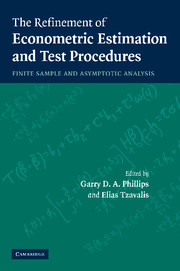Book contents
- Frontmatter
- Contents
- List of figures
- List of tables
- List of contributors
- Preface
- Acknowledgements
- Michael Magdalinos 1949–2002
- Introduction
- 1 Conditional Heteroskedasticity Models with Pearson Disturbances
- 2 The Instrumental Variables Method Revisited: On the Nature and Choice of Optimal Instruments
- 3 Nagar-Type Moment Approximations in Simultaneous Equation Models: Some Further Results
- 4 Local GEL Methods for Conditional Moment Restrictions
- 5 Limit Theory for Moderate Deviations From a Unit Root Under Weak Dependence
- 6 The Structure of Multiparameter Tests
- 7 Cornish-Fisher Size Corrected t and F Statistics for the Linear Regression Model with Heteroscedastic Errors
- 8 Non-Parametric Specification Testing of Non-Nested Econometric Models
- 9 Testing for Autocorrelation in Systems of Equations
- 10 Alternative Approaches to Estimation and Inference in Large Multifactor Panels: Small Sample Results with an Application to Modelling Asset Returns
- 11 Judging Contending Estimators by Simulation: Tournaments in Dynamic Panel Data Models
- 12 A Statistical Proof of the Transformation Theorem
- 13 On the Joint Density of the Sum and Sum of Squares of Non-Negative Random Variables
- 14 Conditional Response Analysis
- References
- Index
1 - Conditional Heteroskedasticity Models with Pearson Disturbances
Published online by Cambridge University Press: 22 September 2009
- Frontmatter
- Contents
- List of figures
- List of tables
- List of contributors
- Preface
- Acknowledgements
- Michael Magdalinos 1949–2002
- Introduction
- 1 Conditional Heteroskedasticity Models with Pearson Disturbances
- 2 The Instrumental Variables Method Revisited: On the Nature and Choice of Optimal Instruments
- 3 Nagar-Type Moment Approximations in Simultaneous Equation Models: Some Further Results
- 4 Local GEL Methods for Conditional Moment Restrictions
- 5 Limit Theory for Moderate Deviations From a Unit Root Under Weak Dependence
- 6 The Structure of Multiparameter Tests
- 7 Cornish-Fisher Size Corrected t and F Statistics for the Linear Regression Model with Heteroscedastic Errors
- 8 Non-Parametric Specification Testing of Non-Nested Econometric Models
- 9 Testing for Autocorrelation in Systems of Equations
- 10 Alternative Approaches to Estimation and Inference in Large Multifactor Panels: Small Sample Results with an Application to Modelling Asset Returns
- 11 Judging Contending Estimators by Simulation: Tournaments in Dynamic Panel Data Models
- 12 A Statistical Proof of the Transformation Theorem
- 13 On the Joint Density of the Sum and Sum of Squares of Non-Negative Random Variables
- 14 Conditional Response Analysis
- References
- Index
Summary
Introduction
The Autoregressive Conditional Heteroskedasticity (ARCH) model was introduced by Engle (1982). In this model the conditional variance of the errors is assumed to be a function of the squared past errors. Engle derives the Maximum Likelihood (ML) estimator for the ARCH model under the assumption that the conditional density of the error term is normal. Bollerslev (1986), suggested the Generalized Autoregressive Conditional Heteroskedasticity model (GARCH) in which the conditional variance of the errors is assumed to be a function of its lagged values and the squared past errors. Bollerslev derives the Maximum Likelihood (ML) estimator for the GARCH model under the assumption that the conditional density of the error term is normal. The ARCH and GARCH models are useful in modelling economic phenomena, mainly in the theory of finance (see e.g., Bollerslev et al. 1992 and Engle, 2002). In the above models the conditional density of the error term is assumed to be normal but in the applications with actual data, distributions other than the normal have been observed with fatter tails or with skewness significantly different from zero. For this reason, in particular applications with real data, other distributions have been used. Bollerslev (1987) used the Student's t distribution to model the monthly returns composite index. Baillie and Bollerslev (1989) also used the Student's t distribution while Hsieh (1989) chose the mixture Normal–Lognormal to model daily foreign-exchange rates.
- Type
- Chapter
- Information
- The Refinement of Econometric Estimation and Test ProceduresFinite Sample and Asymptotic Analysis, pp. 1 - 33Publisher: Cambridge University PressPrint publication year: 2007
- 4
- Cited by



